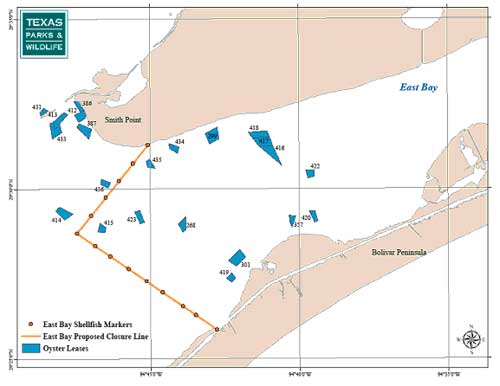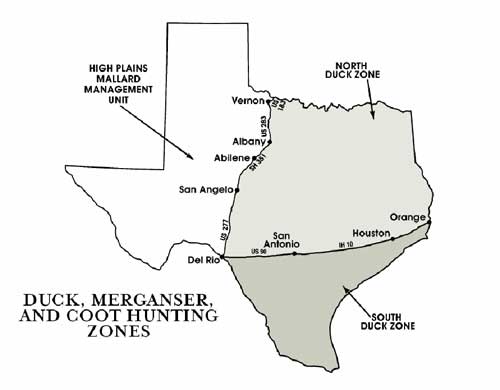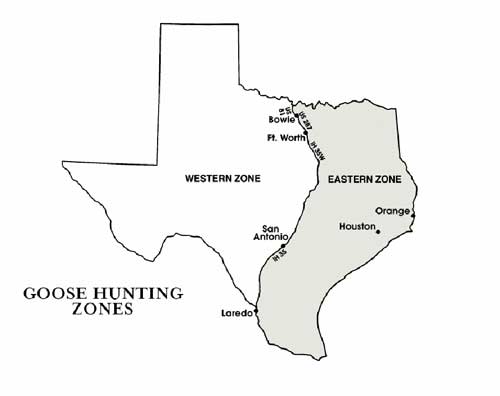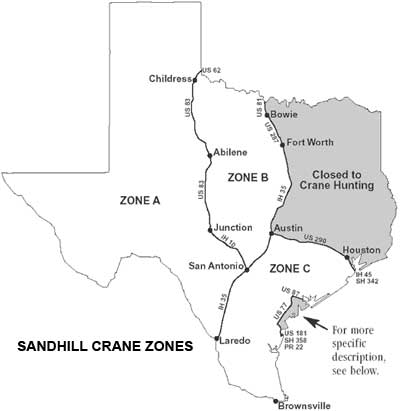Regulations Committee
Wednesday, 9:00 am, May 27, 2009
Texas Parks and Wildlife DepartmentCommission Hearing Room
4200 Smith School Road, Austin, TX 78744
Commissioner T. Dan Friedkin, Committee Chair
Scott Boruff, Committee Liaison
Approval of Previous Meeting Minutes
- Update on TPWD Progress in Implementing the TPWD Land and Water Resources Conservation and Recreation Plan – Permission to Publish Rules Related to Implementation of Legislation during 81st Texas Legislature
Staff: Carter Smith - Proposed Oyster Restoration Rules – Permission to Publish Proposed Changes in the Texas Register
Staff: Robin Riechers - Migratory Game Bird Proclamation
- Proposed Early Season Regulations
- Permission to Publish Proposed Late Season Migratory Regulations
- Raptor Proclamation – Federal Certification of TPWD Falconry Rules – Permission to Publish Proposed Changes in the Texas Register
Staff: Matt Wagner - Exotic Species – Water Spinach Regulations – Permission to Publish Proposed Changes in the Texas Register
Staff: Earl Chilton - Deer Tagging and Documentation Requirement - Recommended Adoption of Proposed Changes (Action Item No. 9)
Staff: Clayton Wolf - Public Hunting Lands Approval (Action Item No. 8)
- Open Season on Public Hunting Lands
- Public Hunting Activities on State Parks
Committee Agenda Item No. 1
Presenter: Carter Smith
Regulations Committee
Update on TPWD Progress in Implementing the
TPWD Land and Water Resources Conservation and Recreation Plan
May 27, 2009
I. Executive Summary: Executive Director Carter Smith will briefly update the Commission on the status of the agency's efforts to implement the Land and Water Resources Conservation and Recreation Plan (the Plan).
II. Discussion: In 2001, the 77th Texas Legislature directed that the Texas Parks and Wildlife Department (TPWD) develop a Land and Water Resources Conservation and Recreation Plan (Tex. Park & Wild. Code §11.104). In November 2002, the Texas Parks and Wildlife Commission (the Commission) adopted the first Plan. A revised Plan was adopted by the Commission in January 2005. The Plan is available on the TPWD web site. Executive Director Carter Smith will update the Regulations Committee on TPWD's recent progress in achieving the Plan's Goals and Objectives as they relate to the Regulations Committee.
The Plan consists of 8 Goals and a total of 56 Objectives. The Goals stated in the Plan are as follows:
- Goal 1: Improve access to the outdoors.
- Goal 2: Preserve, conserve, manage, operate, and promote agency sites for recreational opportunities, biodiversity, and the cultural heritage of Texas.
- Goal 3: Assist landowners in managing their lands for sustainable wildlife habitat consistent with their goals.
- Goal 4: Increase participation in hunting, fishing, boating and outdoor recreation.
- Goal 5: Enhance the quality of hunting, fishing, boating and outdoor recreation.
- Goal 6: Improve science, data collection and information dissemination to make informed management decisions.
- Goal 7: Maintain or improve water quality and quantity to support the needs of fish, wildlife and recreation.
- Goal 8: Continuously improve TPWD business management systems, business practices and work culture.
Committee Agenda Item No. 2
Presenter: Robin Riechers
Regulations Committee
Proposed Oyster Restoration Rules for East Bay Permission of Publish Proposed Changes in the Texas Register
May 27, 2009
I. Executive Summary: In order to protect the restoration efforts of the damaged oyster reef(s) in the East Bay area of the Galveston Bay Complex, the Coastal Fisheries Division is recommending that the area be closed for two harvest seasons until the restoration efforts, which are beginning this year, can produce market size oysters.
II. Discussion: Hurricane Ike caused extensive damage to the oyster reef habitat (reefs) in East Bay within the Galveston Bay Complex. The damage is mainly caused by siltation on the reefs or a covering of the reef material with sediments. This siltation does not allow for spat to set on the reef and to begin the process of oyster reef repopulating in the area. In order to repopulate the reefs in East Bay, the department is beginning restoration work that is being funded with a federal disaster relief grant from Hurricanes Katrina and Rita. Restoration activities will be conducted by placing additional cultch (reef) material on these damaged areas. This will allow spat (juvenile oysters) to attach to the material and for restoration to begin. The Coastal Fisheries Division is asking to close the East Bay approved area as designated by the Department of State Health Services (DSHS) in Galveston Bay for two harvest seasons which will allow for the oyster habitat to repopulate with oysters and for those oysters to reach market size. The closure boundary currently is used to mark the approved area for harvesting but since it is a commonly known boundary it will mark the closed area to the east of the line.
Attachments – 2
Committee Agenda Item No. 2
Exhibit A
Oyster Restoration Rules for East Bay
Proposed Changes
Add underlined indicates the changes to text to Section 58.21 Taking or Attempting to Take Oysters from Public Oyster Beds: General Rules.
(c) Area Closures
(1) There is no open public season for oysters from areas declared to be restricted or prohibited by the Texas Department of Health or areas closed by the Commission.
(2) Until Sept. 1, 2011 the area eastward of a line beginning at the Intracoastal Waterway Channel Marker 4 at Sievers Cove (29° 25’ 51.3”, 94° 42’ 46.2”), to Galveston Shellfish Marker A (29° 26’ 17.2”, 94° 43’ 28.9”), to Galveston Shellfish Marker B (29° 26’ 32.7”, 94° 43’ 54.5”), to Galveston Shellfish Marker C (29° 26’ 57.5”, 94° 44’ 35.5”), to Galveston Shellfish Marker D (29° 27’ 17.2”, 94° 45’ 07.9”),to Galveston Shellfish Marker E (29° 27’ 39.0”, 94° 45’ 44.0”), to Galveston Shellfish Marker F (29° 28’ 01.2”, 94° 46’ 20.7”), to Galveston Shellfish Marker G (29° 28’ 19.7”, 94° 46’ 51.2”), to Galveston Shellfish Marker H (29° 28’ 42.0”, 94° 47’ 28.0”), to Galveston Shellfish Marker I (29° 29’ 13.2”, 94° 46’ 59.3”),to Galveston Shellfish Marker J (29° 29’ 45.4”, 94° 46’ 29.6”), to Galveston Shellfish Marker K (29° 30’ 14.6”, 94° 46’ 02.8”), to Galveston Shellfish Marker L (29° 30’ 45.3”, 94° 45’ 34.5”), to the Smith Point Tide Gauge Piling (29° 31’ 17.9”, 94° 45’ 04.5”) will be closed to the harvest of oysters from public oyster bed (reef) during the open public season.
Committee Agenda Item No. 2
Exhibit B
Proposed East Bay Closure Site

Committee Agenda Item No. 3
Presenter: Dave Morrison
Corey Mason
Regulations Committee
Migratory Game Bird Proclamation
Potential Changes
May 27, 2009
I. Executive Summary: This item:
- updates the Committee on the status of proposed rulemaking concerning early-season species of migratory game birds (dove, teal, rail, gallinule, snipe, and woodcock);
- seeks permission to publish proposed late-season migratory game bird regulations (ducks, geese, and cranes) in the Texas Register for public comment; and
- updates the Committee on the scoping and public input process for migratory game bird rules.
II. Discussion: Responsibility for establishing seasons, bag limits, means, methods, and devices for harvesting migratory game birds within U.S. Fish and Wildlife Service (Service) frameworks is delegated to the Commission under Chapter 64, Subchapter C, Parks and Wildlife Code. Parks and Wildlife Code, §64.022, authorizes the Executive Director, after notification of the Chairman, to engage in rulemaking.
The Service has not yet issued the annual regulatory frameworks for migratory game birds. Typically, the Service issues the preliminary early-season frameworks in late June and the preliminary late-season frameworks in early August.
At the March 2009, meeting of the Regulations Committee, staff received authorization to publish proposed early-season migratory game bird regulations in the Texas Register for public comment. The proposed amendments appeared in the April 24, 2009, issue of the Texas Register (34 TexReg 2595). Because there is not a Commission meeting between May and August, the Executive Director must adopt the proposed early-season rules following the release of the federal frameworks in late June in order to have the rules take effect before the opening day of dove season on September 1. The proposed late-season provisions will be presented to the Commission for adoption at the August Commission meeting.
Attachments – 3
- Exhibit A – Proposed Early Season Rules
- Exhibit B – Recommended Late Season Provisions
- Exhibit C – Late Season Zone Maps
Committee Agenda Item No. 3
Exhibit B
Recommended Late Season Migratory Game Bird Seasons And Bag Limits
DUCKS, MERGANSERS, AND COOTS
- High Plains Mallard Management Unit (HPMMU):
- Oct. 24 – 25 and Oct. 30 – Jan. 24.
- South Zone:
- October 31 – Nov. 29 and Dec. 12 – Jan. 24
- North Zone:
- October 31 – Nov. 29 and Dec. 12 – Jan. 24
Daily Bag Limit: Six ducks, with the following species and sex restrictions: five mallards (of which only two may be hens), three wood ducks, two scaup, two redheads, one pintail, one canvasback, and one “dusky duck” (mottled duck, Mexican-like duck, black duck and their hybrids).
GEESE
- Western Zone:
- Light and dark geese: Nov. 7 – Feb. 7.
- Daily Bag Limit:
- Light geese – 20 in the aggregate;
- Dark geese – Four Canada geese and one white-fronted goose.
- Eastern Zone:
- Light Geese and Canada Geese – Oct. 31 – Jan. 31
- White-fronted Goose – Oct. 31 – Jan. 10
- Daily Bag Limit:
- Light geese – 20 in the aggregate;
- Dark geese – Three Canada geese and two white-fronted geese.
LIGHT GOOSE CONSERVATION ORDER
- Western Zone: Feb. 8 – March 28
- Eastern Zone: Feb. 1 – March 28
YOUTH WATERFOWL SEASON
- HPMMU: Oct. 17 – 18
- North and South zones: Oct. 24 – 25
SANDHILL CRANES
- Zone A: Nov. 7 – Feb. 7 Bag/ Possession Limit: 3/6
- Zone B: Nov. 27 – Feb. 7 Bag/ Possession Limit: 3/6
- Zone C: Dec. 26 – Jan. 31 Bag/ Possession Limit: 2/4
EXTENDED FALCONRY SEASON
- Ducks (North and South zones): Jan. 25 – Feb. 8
- Ducks (HPMMU): No extended season
Committee Agenda Item No. 3
Exhibit C



Committee Agenda Item No. 4
Presenter: Matt Wagner
Regulations Committee
Raptor Proclamation – Federal Certification of State Falconry Rules
Permission to Publish Proposed Changes in the Texas Register
May 27, 2009
I. Executive Summary: This item seeks permission to publish proposed changes to state falconry regulations in order to enable federal certification.
II. Discussion: Under Parks and Wildlife Code, Chapter 49, the Commission may prescribe rules for the taking, capture, possession, propagation, transportation, export, import, and sale of raptors, the times and areas from which raptors may be taken or captured, and species that may be taken or captured; provide standards for possessing and housing raptors held under a permit; prescribe annual reporting requirements and procedures; prescribe eligibility requirements and fees for and issue any falconry, raptor propagation, or nonresident trapping permit; and require and regulate the identification of raptors held by permit holders.
The practice of falconry is regulated at both the state and federal levels by the Texas Parks and Wildlife Department (the department) and the U.S. Fish and Wildlife Service (the Service), respectively. The federal authority to regulate falconry is derived from the Migratory Bird Treaty Act, an international treaty to which the United States is a signatory. As with all migratory bird rules, the states may adopt rules that are more restrictive than the federal rules, but may not adopt rules that are less restrictive.
Under current state and federal rules, an applicant for a state falconry permit must apply for a federal falconry permit concurrently with the application for a state permit. The Service has recently conducted a significant revision of the federal falconry rule. Part of that revision allows states that meet the federal falconry standards to handle falconry permitting with a single state permit application. In those states, the state becomes, in effect, an administrative agent of the Service. In states that do not participate in joint federal/state falconry certification, applicants must continue to apply for state and federal falconry permits separately. Texas falconers have expressed a strong desire to be administratively regulated by the department alone.
As a consequence of the new federal falconry regulations, the Texas falconry rules are at variance with the federal rules in some instances. Federal rules require federal certification of state rules by September 1, 2009 if the state is to take advantage of the joint permitting program. The proposed amendments would make provisional alterations necessary to temporarily eliminate conflicts with federal falconry rules, which will allow for the certification of the state program by the Service. Meanwhile, the department is currently involved with the regulated community to develop new falconry regulations, which should be ready within the year.
Attachments – 1
- Exhibit A – Examples of Federal/State Rules Differences
Committee Agenda Item No. 4
Exhibit A
Examples of State/Federal Falconry Rules Differences
- The new federal rules require falconers to have a minimum of at least two years of experience as a general permittee before they can sponsor an apprentice falconer. Current state rules require only that a sponsor be a general or master permittee.
- The new federal rules allow the possession of native eagles only by master permittees who meet certain qualifications. Current state rules currently allow general or master permittees to possess native eagles.
- The new federal rules require falconers to retake the falconry examination after permit lapses of five years or longer. Current state rules do not address this scenario.
- The new federal rules require goshawks to be banded. Current state rules do not require goshawks to be banded.
- The new federal rules require that lost identification bands be reported within five days. There is no such requirement in state rules.
- The new federal rules stipulate that a falconer may not take more than two raptors from the wild in any year. Current state rules stipulate only a possession limit.
- The new federal rules require that a falconer who captures a raptor bearing a band, transmitter, or any other item identifying it as a falconry bird must report the capture within five days and the bird must be returned to the person who lost it. Current state rules do not address such a scenario.
- The new federal rules require a falconer trapping from the nest to leave at least one offspring in the nest or aerie. Current state rules do not address this scenario.
- The new federal rules require falconers to retain administrative records to be retained for a minimum of five years after a bird is transferred, lost, or has died.
- The new federal rules require at least two radio transmitters to be attached to hybrid raptors at any time they are flown. Current state rules do not address this scenario.
- The new federal rules prohibit the release of hybrids to the wild. Current state rules do not address this scenario.
Committee Agenda Item No. 5
Presenter: Matt Wagner
Regulations Committee
Exotic Species – Water Spinach Regulations
Permission to Publish Proposed Changes in the Texas Register
May 27, 2009
I. Executive Summary: Staff will brief the Commission on the current status of water spinach, Ipomoea aquatica in Texas. Staff will recommend amendments to the Harmful or Potentially Harmful Exotic Fish, Shellfish and Aquatic Plants rules that will require all retailers, and or wholesalers to purchase water spinach from Exotic Species permit holders, retain water spinach invoices, and sell water spinach for personal consumption only.
II. Discussion: Water spinach, which is currently on the Texas Parks and Wildlife Department (department) prohibited plant list, has been cultured for over 20 years in the Houston area. Extensive habitat surveys by staff biologists in the past have revealed no evidence of water spinach in public waters. A recent risk analysis completed by staff has determined that the culture of water spinach poses little threat to the state's aquatic resources provided that it is grown inside greenhouses and sold only for personal consumption. Therefore, staff recommends that retail and wholesalers be allowed to possess and sell water spinach for personal consumption provided they purchase it from growers who possess an Exotic Species permit from the department. Staff requests permission to publish the proposed changes in the Texas Register for public comment.
Top of Page^